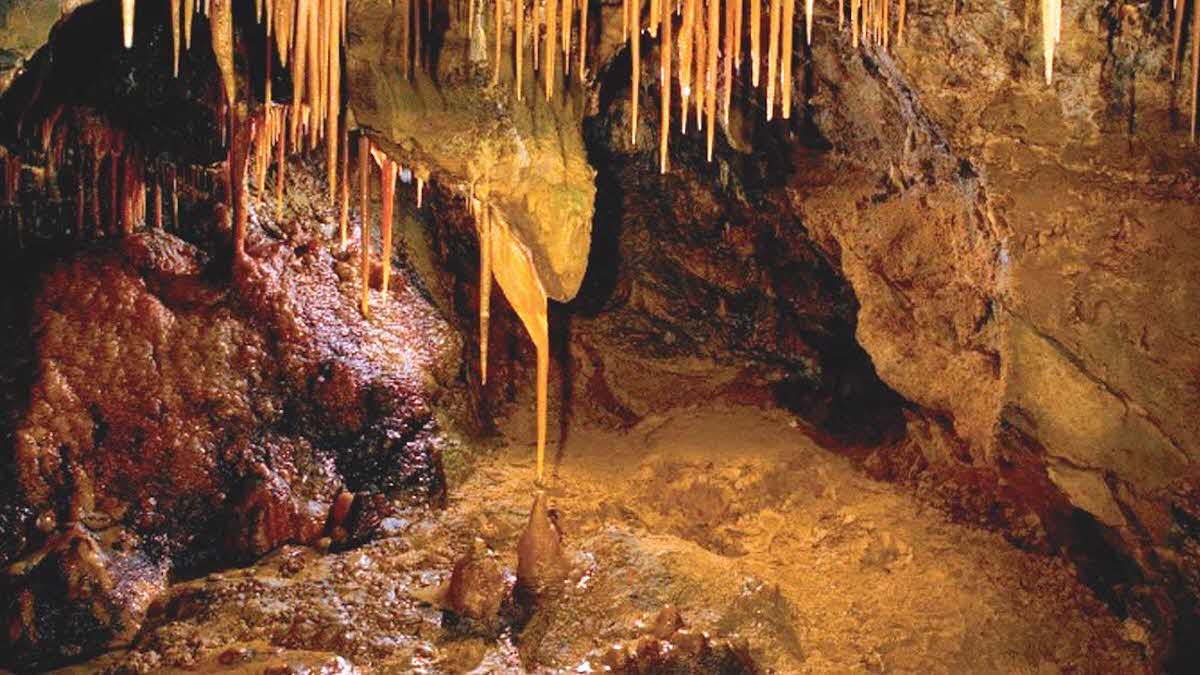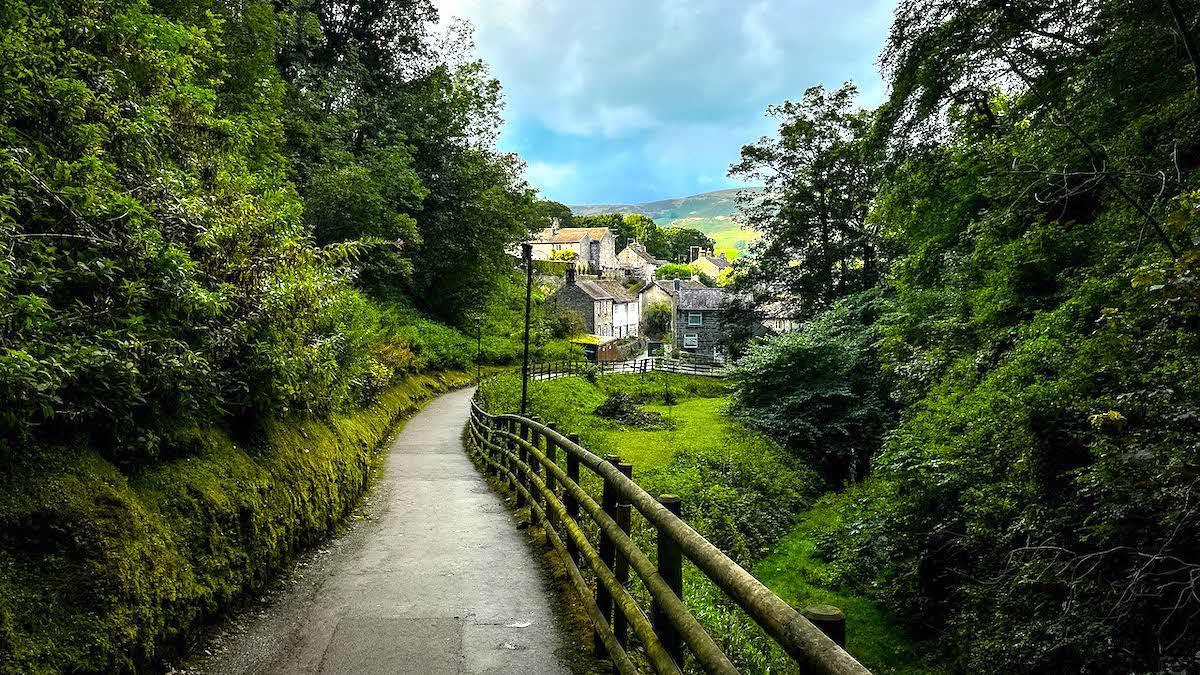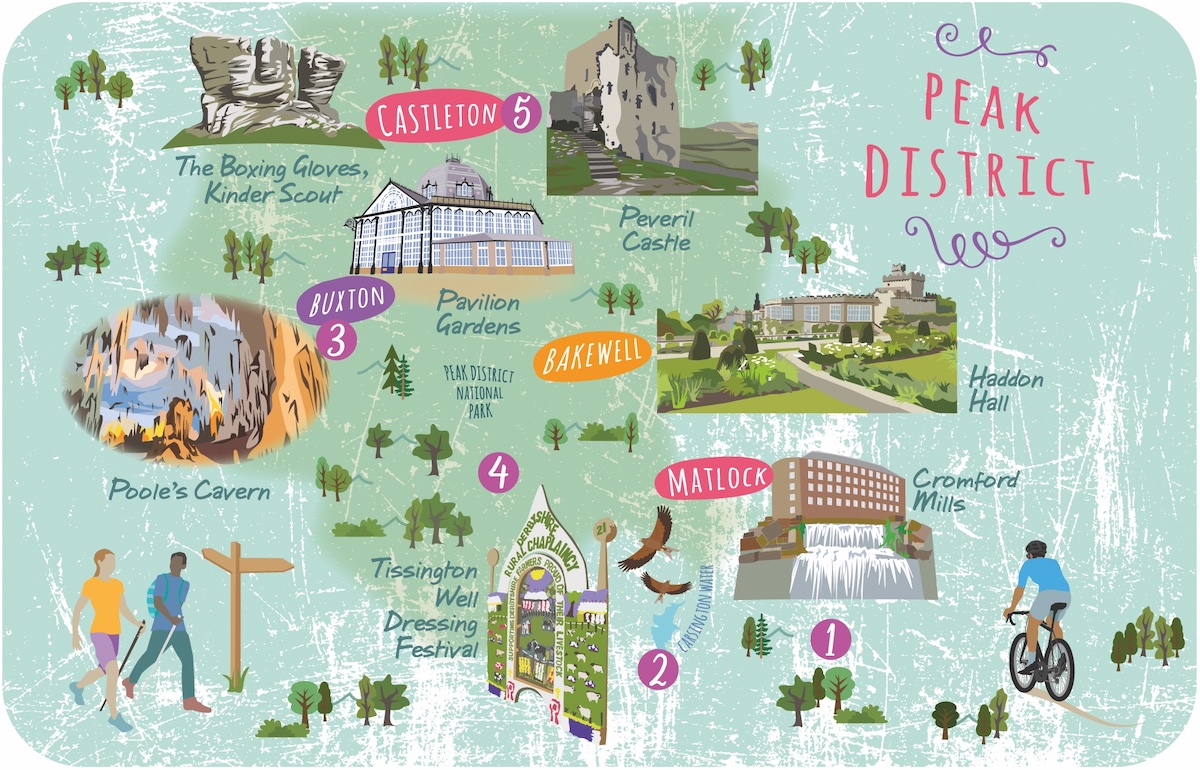Book a Club campsite
Search and book a great value holiday today
Book nowPhilip Moon visits five sites in the Peak District and surrounds
 The Firs Club Campsite. Photo by member Katie Dudley
The Firs Club Campsite. Photo by member Katie Dudley
The Peak District and its surrounds offer visitors the opportunity to enjoy everything from walking, cycling and water sports to visiting stately homes, transport museums, underground caverns and historic mills. That’s before we even mention the beautiful countryside. My base for the week is The Firs Club Campsite, just outside Belper, but I’ll be visiting a number of other Club sites and CLs during my stay. Let’s find out what makes each one special and what they have to offer.
The Firs is a pleasant, medium-sized site in a quiet location. Pitches to the rear of the site command great views over the countryside, while those with canine companions will be pleased to find that there’s an off-lead dog walking area. The site is also very conveniently located for visiting the many attractions nestling along the Derwent Valley. [These attractions are also close to Lickpenny Matlock Club Campsite, the Club’s newest location, which sits to the east of Matlock and Matlock Bath.]
Tuesday, and my first visit is to Cromford Mills, just under seven miles from The Firs. Built originally in 1771 by Richard Arkwright, inventor of the water frame, it pioneered the factory system. Such is its historical importance that it forms part of the Derwent Valley Mills UNESCO World Heritage Site. I join a fantastic tour led by volunteer guide, Bev, whose knowledge is immense. Arkwright himself makes an appearance in holographic form to tell us how, from humble beginnings, he became one of the richest men in Britain. The mill yard also includes a café, a cheese shop, a plant stall, and a second-hand bookshop – so allow yourself two to three hours for a visit.
 The Heights of Abraham, Matlock Bath
The Heights of Abraham, Matlock Bath
My next port of call is the Heights of Abraham at Matlock Bath. Parking at the railway station car park, it’s a short walk to a cable car which whisks you up the side of the valley to the Heights, a tourist attraction since the 1780s. The views are spectacular and there’s lots to do – not only do you have the opportunity to explore the hilltop country park, but also its underground caverns, rock shop and exhibitions. One of these tells the story of the Heights as an attraction, while the other shows the fashions worn by visitors over the years. I opt for a tour of Masson Cavern and gain a lesson in geology, which covers the formation of the cave and how it was mined for lead in the 17th century. Club members receive a 20% discount on entry to the Heights of Abraham attraction – see camc.com/greatsavingsguide for details.
Headed back towards The Firs, I drop in on the Great British Car Journey, where Club members can again take advantage of a discount (£3.50). This fascinating motoring museum is only about a mile and a half from the site and well worth the visit.
As Richard Usher, the man responsible for the collection, explains in his introduction to the audio guide, it’s about preserving popular cars and not just the exotic ones. There are more than 150 in the collection, which charts the history of the British motor industry from the 1920s to the 1980s.
A related attraction at the museum called ‘Drive Dad’s Car’ offers visitors the opportunity to pilot some of the vehicles – with over 35 classic British cars just waiting to be taken on the road, it could be a rather special present for a loved one.
Wednesday, and my focus today is on Carsington Water Club Campsite, a magnificent spot located close to the southern end of the eponymous reservoir and set in a pine forest. Assistant Site Manager Ian describes it as “Paradise in the Peaks”. His partner and fellow manager Liz elaborates: “Natural, quiet, peaceful – just listen to the birds singing in the trees!”
It’s a short distance to Carsington Water’s visitor centre. Here there are cafés, shops and an exhibition by Severn Trent, explaining how water is managed and transferred to the home and things we can all do to save this precious resource.
There’s also an RSPB shop at which you can hire binoculars and catch up on the latest sightings; today the list includes buzzards, sparrowhawks and hobbies as well as pochards, warblers and sandpipers.
Adjacent to the visitor centre is the water sports centre, where you can hire canoes, paddleboards or sailing dinghies; boat trout fishing is also available.
I’m not going on the water today – I’m off on a two-wheeled adventure. From the visitor centre, I pick up National Cycle Route 547, which heads west towards Tissington. It mostly follows narrow off-road tracks or very quiet roads. There are some hills, which a few years ago I would have considered ‘moderate’, but now, with my aging limbs, I’d recategorise as ‘demanding’. Time for an electric bike perhaps?

Treak Cliff Cavern
Tissington is a delightful village, centred around Tissington Hall (see tissingtonhall.co.uk for visiting information) and the associated Herbert’s Tea Rooms.
I’m particularly lucky that my visit coincides with the well-dressing festival, held each year in the week following Ascension Thursday (information about Tissington’s well dressing in 2025 will be available on the hall’s website in due course). This tradition dates to a time when locals decorated their wells to give thanks to the God for their water supply; other villages in Derbyshire follow a similar custom.
At Tissington I join the Tissington Trail (Route 68), heading north. It’s a disused railway line, graded and gravelled, so fairly easy cycling. After about six miles I branch off east onto Route 548, which links with the High Peak Trail – another former railway line. A spur then takes me down through Hopton and Carsington. The last leg hugs the western edge of the reservoir and back to the Club site – a total of 26.5 miles.
On Thursday I’m headed for Buxton, calling en route at Haddon Hall, located just off the A6 between Rowsley and Bakewell. It is one of several historic houses in the area, with others including Chatsworth, Hardwick and Kedleston Hall (the latter two being National Trust properties).
Haddon Hall is charming, commanding attractive views of the River Wye, which runs through its grounds. The hall’s origins date back to the Norman and Saxon eras, although the buildings are mostly late medieval and Tudor. The chapel is particularly interesting, featuring medieval wall paintings depicting the stories of St Nicholas and St Christopher. There’s a free guided tour of the hall on Mondays, but there are ‘spotlight talks’ on particular parts on other days, so check out haddonhall.co.uk when planning your visit. There’s a 20% discount off the entry price for Club members.
Buxton was developed in Georgian and Victorian times to rival the spa towns of Harrogate and Bath, and to this day it retains an air of cultured gentility, with its Opera House and various festivals. Buxton Club Campsite lies on the edge of town in what was once a limestone quarry. Site Managers Tracey and Richard report resident barn and tawny owls as well as visiting badgers, foxes and jackdaws. Tracey adds that you might also spot some rare and protected wildflowers. The site adjoins a 100-acre wood; in early May, when I drop in, the trees are fresh and verdant, and I’m told they are equally splendid in autumn.
I take the path through the woods to one of Buxton’s special attractions – Poole’s Cavern. It’s a large natural cave adorned with magnificent stalactites and stalagmites – some of which are growing at surprising rates. Myth has it that it was once the abode of a flesh-eating giant… a story probably told to discourage children from entering the cave by themselves. Archaeological evidence shows it has been used by humans since Neolithic times.
On my way back to base I take in one of the Club’s Certificated Locations. Whitehouse Farm, owned by sisters Jean and Pam, is situated on the edge of the tiny village of Heathcote. It’s very rural, very quiet and very beautiful. The views on a clear day would be stunning; today, alas, is wet and grey. The location, within a stone’s throw of the Tissington and High Peak Trails, is ideal for cyclists and walkers – you could also use it as a base from which to explore beauty spots such as Dovedale and the Manifold Valley.
 Castleton, near Castleton Club Campsite. Photo by member Steve Gouldstone
Castleton, near Castleton Club Campsite. Photo by member Steve Gouldstone
Friday is my last day and I’m focusing on Castleton. The Club site here is located between Hope and Castleton; the latter, with its many pubs, cafés and shops, being within easy walking distance. The campsite has excellent facilities including a drying room and a games room equipped for pool and table tennis. “What makes it special?” I ask Assistant Site Manager Tom. He looks at me as if it’s a daft question. “Look around you,” he says, “it’s location, location, location”, pointing up to the magnificent Mam Tor and the other surrounding hills. Castleton’s a brilliant place for a walking holiday – but as I’m not feeling that athletic I choose instead to indulge my historical interests with a visit to Peveril Castle.
Dating from the 12th century, it’s now largely ruined but its keep remains and the views over the Hope Valley make the climb worthwhile.
My next stop is Speedwell Cavern, one of several caverns which surround Castleton. I’ve chosen it because it’s a little different: the trip is by boat. Time for hard hats and keeping heads low as we make our way through the passageways, excavated 200 years ago by lead miners. Eventually we emerge in a magnificent cavern likened by some to a cathedral. Here we disembark for a good look around and to stare into the abyss of the flooded ‘Bottomless Pit’. Our guide tells us of the cunning system of warning bells in place to alert us in case of suddenly rising waters.
I finish off my visit with a stroll around the village. Not only are there the aforementioned pubs and cafés, but also several jewellery shops offering pendants, cufflinks, earrings and the like made with the attractive Blue John stone excavated from local caverns. There’s also a visitor centre which has an interesting exhibition on the history of the area. Alas, it’s now time for me to head home, but there’s more to see and do, and I’ll be back.
 Illustration by Louise Turpin
Illustration by Louise Turpin
You can use the Outdooractive app to enjoy a variety of walking routes in the region. The basic app is free to use, but Club members benefit from a €10 discount on Pro or Pro+ first-year subscriptions. With the Pro version you receive features such as access to topographical maps and special activity networks, while Pro+ gives you 3D maps and more. To find out more and to see a collection of routes near Club sites, see camc.com/outdooractive.